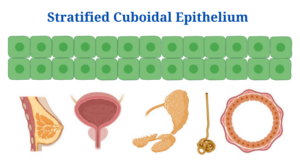Definition of Stratified Cuboidal Epithelium
An epithelium with cuboidal cells inside the apical layer and columnar cells with in deeper layer is called stratified cuboidal epithelium. Because of this, cells inside the deeper layers of squamous epithelium could vary from those in the top layer. Position as well as role of the epithelial tissue influence the apical surface modification. This epithelium is extremely uncommon and only occurs in a few places all through the body.
Stratified Cuboidal Epithelium Structure
- Cells upon that outermost layer of the stratified cuboidal epithelium are cube-shaped, and they are arranged in layers.
- The lowest, denser strata can have a cuboidal or columnar structure to them, depending on their depth.
- There really are no gaps between the cells because they are densely packed.
- Basal layer is connected to foundation membrane whereas remainder of layers are linked to preserve structural stability of epithelium as a whole.
- Excluding the apical surface of the outermost layer, that is accessible to the lumen of the organ, the cells are held together by tight junctions such as desmosomes or gap junctions.
- With each division, fresh layers of cells are added to the basal layer, forming new layers of cells on top. As a result of this, the epithelium in that region may be able to more effectively adapt to these cells.
- Apical cells that have lost their cell connections are shed, while new cells grow from the basal layer to substitute them.
- No direct supply exists in the epithelium. It is by diffusion that the epithelium is supplied with the required nutrient, water, as well as oxygen.
- It’s true that the epithelium is supplied with its own nerves.
Image Created with BioRender
Stratified Cuboidal Epithelium Functions
Even as epithelium only covers some organs in the body, its roles are also determined by the organs.
(a) Protection
- Protection is the fundamental purpose of stratified epithelium.
- To prevent physical as well as microbiological harms, the epithelium comprises many layers.
- As a result of gap junctions and desmosomes, foreign particles are prevented from entering the cells.
- However, this epithelium also works as a gatekeeper, sweeping out undesired particles yet admitting water and nutrients into the cells.
- Since body’s cells are constantly being repaired as well as replaced, they serve as the body’s initial layer of defense.
(b) Absorptive and secretory mechanisms
- Absorption and secretion is also limited by the stratified cuboidal epithelium.
- There is a small amount of fluid secreted into the duct by the epithelium that surrounds specific glandular organelles’ ducts, among other things.
- An epithelial layer with in urethra also collects water as well as certain ions from urine.
Stratified Cuboidal Epithelium Location and Examples
- Cuboidal epithelium is present in the endocrine system as the lining of salivary gland, sweat gland, and mammalian gland ducts.
- Additionally, it can also be present in male urethra and other urinary system elements.
Stratified Cuboidal Epithelium Citations
- Waugh A and Grant A. (2004) Anatomy and Physiology. Ninth Edition. Churchill Livingstone.
- https://quizlet.com/118694985/tissue-level-of-organization-ch-4-flash-cards/
- https://www.differencebetween.com/difference-between-simple-stratified-and-pseudostratified-epithelial-tissue/
- https://www.toppr.com/guides/biology/tissues/epithelial-tissue/
- https://www.thoughtco.com/integumentary-system-373580
- https://www.ncbi.nlm.nih.gov/pmc/articles/PMC3175552/
- https://www.kenhub.com/en/library/anatomy/stratified-epithelium
- https://onlinelibrary.wiley.com/doi/full/10.1111/j.1600-0420.2006.00840.x
- https://bodytomy.com/functions-of-epithelial-cells
Related Posts
- Phylum Porifera: Classification, Characteristics, Examples
- Dissecting Microscope (Stereo Microscope) Definition, Principle, Uses, Parts
- Epithelial Tissue Vs Connective Tissue: Definition, 16+ Differences, Examples
- 29+ Differences Between Arteries and Veins
- 31+ Differences Between DNA and RNA (DNA vs RNA)
- Eukaryotic Cells: Definition, Parts, Structure, Examples
- Centrifugal Force: Definition, Principle, Formula, Examples
- Asexual Vs Sexual Reproduction: Overview, 18+ Differences, Examples
- Glandular Epithelium: Location, Structure, Functions, Examples
- 25+ Differences between Invertebrates and Vertebrates
- Lineweaver–Burk Plot
- Cilia and Flagella: Definition, Structure, Functions and Diagram
- P-value: Definition, Formula, Table and Calculation
- Nucleosome Model of Chromosome
- Northern Blot: Overview, Principle, Procedure and Results

















